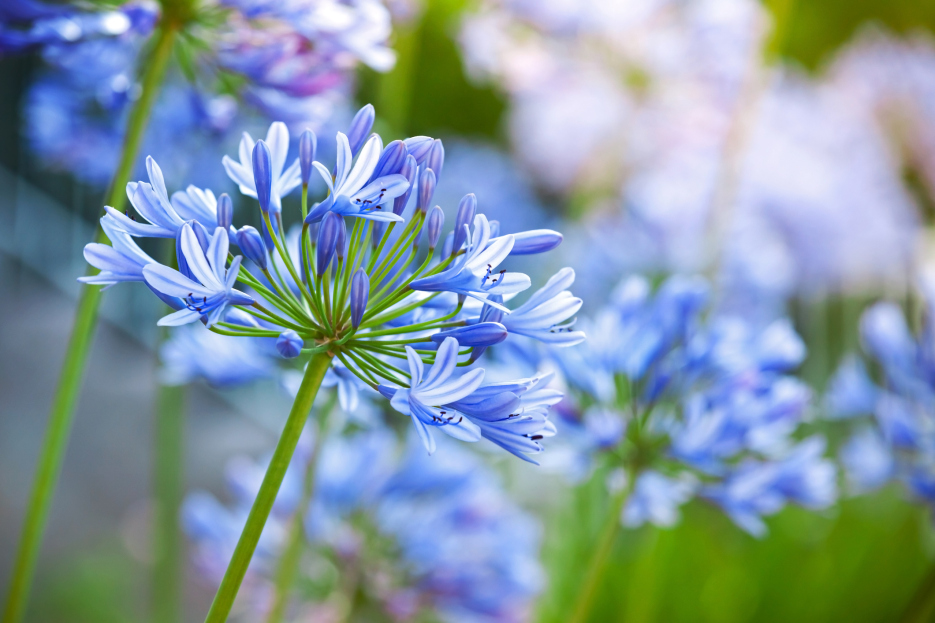
Agapanthus, commonly known as the African lily or lily of the Nile, is a stunning perennial plant that produces beautiful clusters of trumpet-shaped flowers in shades of blue, purple, or white. Known for its striking appearance and long-lasting blooms, Agapanthus is a popular choice for gardeners looking to add a touch of elegance to their landscapes or indoor plant collections. Whether you're growing it outdoors or in containers, here's a comprehensive guide on how to care for Agapanthus to keep it thriving.
Agapanthus thrives in full sun but can tolerate partial shade, especially in regions with hot summers. For optimal growth and abundant flowering, plant your Agapanthus in a location where it will receive at least 6 hours of direct sunlight per day. Full sun encourages the plant to produce more flowers and grow stronger.
If you're growing Agapanthus indoors, place it near a sunny window where it can receive bright, indirect light. A south-facing window is ideal for indoor plants, but any location with plenty of natural light will work.
Agapanthus prefers well-draining soil that is rich in organic matter. It thrives in slightly acidic to neutral soil with a pH between 6.0 and 7.0. The soil should be moist but not soggy, as the plant is prone to root rot if it sits in waterlogged conditions.
If planting in the ground, amend the soil with compost or well-rotted manure to improve drainage and fertility. For container plants, choose a high-quality potting mix that drains well, and ensure the container has drainage holes to prevent excess water from accumulating at the bottom.
Agapanthus has moderate water needs, but it's important to avoid overwatering, as the plant does not like to sit in soggy soil. Water the plant deeply when the top 1-2 inches of soil feels dry. During its growing season (spring and summer), water regularly to keep the soil consistently moist, but not waterlogged.
In the fall and winter, Agapanthus goes dormant, so reduce watering to allow the plant to rest. If you're growing Agapanthus in a container, check the soil regularly and adjust watering accordingly. Be sure to water the plant thoroughly, ensuring that water reaches the roots.
Agapanthus is a hardy plant that can tolerate a range of temperatures, but it thrives in warm, temperate climates. The ideal temperature range for Agapanthus is between 60°F and 75°F (15°C to 24°C). It can withstand brief periods of cold, but if you live in an area with harsh winters, it’s best to grow Agapanthus in containers so you can bring it indoors during the colder months.
If growing Agapanthus indoors, maintain average room temperatures, and avoid placing the plant in drafty areas or near cold windows. Agapanthus does not require high humidity but will appreciate occasional misting or a humidifier if you live in a particularly dry climate.
Agapanthus benefits from regular feeding during the growing season (spring through summer). Use a balanced, water-soluble fertilizer or one formulated for flowering plants. Apply fertilizer every 4-6 weeks to promote healthy growth and abundant blooms.
In the fall and winter, when the plant is dormant, reduce or stop fertilizing to allow the plant to rest. Over-fertilizing during the dormant period can lead to weak growth and fewer flowers.
Pruning is essential for maintaining the shape and health of your Agapanthus plant. After the plant finishes flowering, cut back the spent flower stalks to the base of the plant. Pruning helps encourage new growth and improves the plant’s overall appearance.
In late fall or early spring, you can trim back any dead or damaged leaves to keep the plant looking tidy. Avoid cutting back too much of the foliage, as Agapanthus relies on its leaves to gather energy for the next growing season.
Agapanthus can become quite large over time, and it may benefit from being divided every 2-3 years. This helps rejuvenate the plant, promotes better flowering, and prevents overcrowding. To divide Agapanthus, carefully lift the plant from the soil, and use a sharp knife or spade to separate the roots into smaller sections. Replant the divisions in well-prepared soil, and water thoroughly.
If growing Agapanthus in containers, you may need to repot the plant every 2-3 years to prevent it from becoming root-bound. Choose a pot that is 1-2 inches larger in diameter than the current one and use fresh, well-draining potting mix.
Agapanthus is relatively resistant to pests, but it may occasionally attract aphids, spider mites, or mealybugs. Keep an eye on the plant for any signs of pests, and treat with insecticidal soap or neem oil if necessary. Additionally, ensure that the plant has good air circulation and avoid overwatering to reduce the risk of fungal diseases, such as root rot.
If you live in a region with cold winters, protect your Agapanthus from frost by bringing it indoors or covering it with a frost cloth. In colder climates, you can grow Agapanthus as a container plant and move it indoors during the winter months to protect it from freezing temperatures.
Agapanthus is generally non-toxic to pets, making it a safe option for homes with cats or dogs. However, it’s always a good idea to prevent pets from chewing on plants, as even non-toxic plants can cause digestive upset if ingested in large quantities.